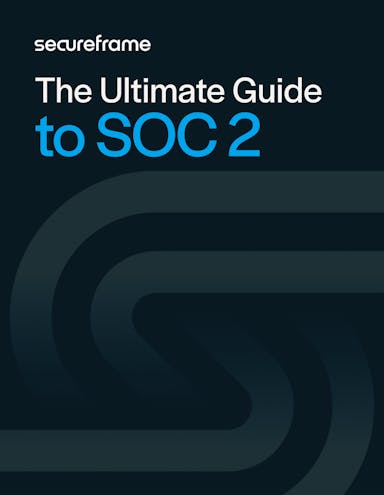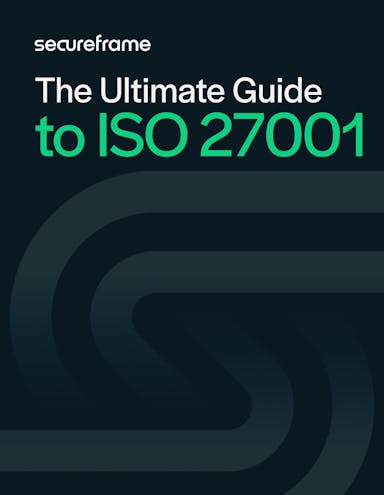
SOC 2 vs ISO 27001: What’s the Difference and Which Standard Do You Need?
Emily Bonnie
Senior Content Marketing Manager
Cavan Leung
Senior Compliance Manager
Which is better, SOC 2 or ISO 27001? It’s a question many fast-growing companies face when deciding which type of compliance to pursue.
It’s a tough question to answer, in part because the two frameworks are so similar. But does one hold more prestige with your customers? Is one objectively better than the other?
Find answers to these questions and more in the SOC 2 and ISO/IEC 27001 comparison below. You’ll not only learn the key differences and similarities between the two compliance frameworks — you’ll also find advice on making the right choice for your SaaS organization.
First, let’s take a look at each individual framework.
What is SOC 2?
Systems and Organization Controls 2 (SOC 2) is a security and compliance standard created by the American Institute of Certified Public Accountants (AICPA). This framework specifies how organizations should protect customer data from unauthorized access, cybersecurity incidents, and other vulnerabilities.
A SOC 2 report attests to the operating effectiveness of an organization’s security protocols and helps establish trust between service providers and their customers.
SOC reports are better known in North America and therefore typically carry more weight than ISO certifications in the US.

The Ultimate Guide to SOC 2
Learn everything you need to know about achieving SOC 2 compliance fast, from Type 1 vs Type 2 reports and selecting your Trust Services Criteria to the actual audit process and requirements.
What is ISO 27001?
ISO 27001 is an international standard for data protection created jointly by the International Organization for Standardization and the International Electrotechnical Commission. This framework outlines the requirements to establish, maintain, and continually improve an information security management system (ISMS).
ISO 27001 certification provides customers with third-party reassurance that the organization has built an ISMS capable of protecting sensitive data.
While ISO 27001 is popular worldwide, it is most commonly requested by international customers, especially in Europe.

The Ultimate Guide to ISO 27001
If you’re looking to build a compliant ISMS and achieve certification, this guide has all the details you need to get started.
What are the similarities between SOC 2 and ISO 27001?
SOC 2 and ISO 27001 are two of the most rigorous security and compliance standards designed to demonstrate to clients that you can be trusted with their data. Both standards are well respected globally.
Both cover foundational security principles like data security, integrity, availability, and confidentiality.
According to the ISO 27001 vs SOC 2 mapping spreadsheet by the AICPA, there’s about an 80% overlap between ISO 27001 and SOC 2 criteria. They also share almost all the same controls, varying by as little as 4%.
They both involve an independent audit by a certified third party — and both require significant time, effort, and money to achieve.
If you’re short on time or resources, you’ll need to decide which type of compliance is best to pursue for your organization. In that case, it’s essential that you know the differences between SOC 2 vs ISO 27001.
What are the differences between SOC 2 and ISO 27001?

Target market
If a majority of your customers are based in the US, you should opt for undergoing a SOC 2 audit. The SOC 2 Type II has become the industry standard framework for third-party reports when it comes to information security compliance in the US.
If a majority of your customer base is outside of the US, you may want to opt for completing an ISO 27001 audit. An ISO 27001 certification is the gold standard for infosec compliance internationally.
That said, many US companies will accept ISO 27001 certification, and many companies outside of the US will accept a SOC 2 report. Ultimately, this decision comes back to what your customers are requesting during their vendor due diligence.
As your company grows, you will likely opt to complete both audits in order to have full coverage across your customer base.
Level of flexibility
With SOC 2, companies can choose which of the five AICPA Trust Services Criteria to include in their audit, and design a system of internal controls that support their selected TSC. Depending on how many criteria they include, organizations need to put between 70 to 150 controls in place and provide documentation and evidence for them. In this way, SOC 2 is a much more flexible framework, allowing companies to adapt service organization controls to their unique systems and services.
ISO 27001, however, focuses more narrowly on information security and has separate standards that cover privacy, business continuity, and other concerns. It has 93 prescribed controls — known as “Annex A controls” — that organizations must implement. If they don’t, then they have to explain why they were excluded in their Statement of Applicability. ISO 27001 also requires exact language to be used in many policy documents as part of the company’s Information Security Management System
Audit Scope
SOC 2 audits typically have a smaller scope than ISO 27001 audits.
Only one TSC— Security — needs to be included in the scope of a SOC 2 audit. The others — Availability, Confidentiality, Privacy, and Processing Integrity — can be included if they are relevant to your organization’s specific services and customer requirements. Availability and confidentiality are commonly included.
A management assertion, system description, and control matrix are required for any SOC 2 audit. Other compliance documentation may be required depending on which TSC you select.
ISO 27001 is more prescriptive than SOC 2. It requires more systems, policies, and procedures and therefore more robust and detailed documentation. Required documentation for any ISO 27001 audit includes an information security policy, a risk assessment and risk treatment plan, a formal internal audit process, Annex A documents, and the Statement of Applicability.
ISO 27001 also requires that you have a plan to evaluate and improve your ISMS over time.
Audit Cost
While costs vary from auditor to auditor, ISO 27001 certification audits are typically more expensive than SOC 2 report audits because ISO requires more documentation to prove a compliant ISMS is in place.
While the exact cost depends on the auditor as well as the scope and complexity of your ISMS and whether you’re pursuing a new certification or completing a surveillance audit, companies can expect to pay $10-50K for an ISO 27001 certification audit on average.
The exact cost of a SOC 2 audit also depends on a range of factors, but companies can expect the cost of a SOC 2 Type 1 audit to be around $10-20K and a SOC 2 Type 2 audit to be around $30-60K on average.
That said, it is possible to receive a substantial discount if you opt to complete both audits with the same auditing firm.
Audit process
For both frameworks, companies must define their security objectives, conduct a gap analysis, implement the necessary controls, accumulate documentation, and establish a method to review and continually improve security processes.
However, assessor requirements are different. An ISO 27001-accredited registrar is required to issue an ISO 27001 certification, while SOC 2 audits must be completed by a licensed CPA firm.
In addition, SOC 2 Type 2 audit reports typically need to be renewed on an annual basis. Most ISO 27001 certificates are valid for three years, with annual surveillance audits and internal audits to ensure your ISO 27001 compliance program is still effective and being maintained. A recertification audit is required after three years.
Audit timeline
A SOC 2 audit typically takes less time to complete than ISO 27001 certification.
For a SOC 2 Type I report, audit readiness takes an average of 3 months of preparation work if you’re not using an automation platform. Once audit-ready, it takes approximately 2 months to conduct the audit and receive the report in hand for both.
For a SOC 2 Type II report, it can take an average of 4 months to get audit-ready. Once ready, the audit assessment can take between 3 to 12 months depending on your desired audit window. Once the audit window has finished, it can take an additional month to address any follow-ups and receive a report in hand.
For an ISO 27001 certification, audit readiness takes an average of 4 months. Once audit-ready, it takes an average total of 6 months to complete Stage 1 and Stage 2 audits (addressing any gaps in between) and receive your report.
Both SOC 2 and ISO 27001 require a substantial amount of time upfront in order to build and implement the right policies, processes, and controls for your company. A compliance automation platform like Secureframe can significantly speed up the process, cutting down the hundreds of hours of manual work needed to prepare for and complete either audit.

Report type
Although both security standards require an external audit, the results of the audit are different.
Only ISO 27001 involves an actual certification. At the completion of an audit, the auditor issues a certificate of compliance that verifies whether the organization meets the International Organization for Standardization (ISO) requirements for protecting information and managing risk.
The result of a SOC 2 audit is an attestation report, which details the auditor’s opinion on whether the organization’s security controls satisfy the relevant Trust Services Criteria.
SOC 2 vs ISO 27001: Which is right for your company?
Both SOC 2 and ISO 27001 are highly respected security frameworks that will strengthen customer confidence in your organization's security posture. Both require a significant commitment in terms of time, money, and effort to achieve. And both will help ensure your organization has best-in-class security practices in place.
So which is a better fit for your company — SOC 2 or ISO 27001 compliance? Or do you need both? Here’s a list of key questions to help you decide whether you need SOC 2, ISO 27001, or both:
- Who are your customers, and where are they located? US companies and service providers often prioritize SOC 2, while international clients may expect ISO 27001.
- Are your customers asking for specific certifications? If clients explicitly request SOC 2 reports or ISO 27001 certification, that is a clear signal for which framework should take precedence.
- What are the industry standards for your business? Certain industries may lean toward one framework. For example, SaaS companies often require SOC 2, while global enterprises expect ISO 27001.
- What are your long-term business goals? If you plan to expand globally, ISO 27001 may be more beneficial over the long term, while SOC 2 is often critical for US markets.
- Are you focused on protecting specific customer data or implementing a more comprehensive information management system? SOC 2 emphasizes customer trust and data protection. ISO 27001 is broader, focusing on helping your organization build, maintain, and continuously improve an ISMS.
- What existing controls, policies, and procedures do you already have? If you already follow best practices, mapping existing your controls to both SOC 2 and ISO 27001 can demonstrate which framework you're closer to achieving compliance with.
- Do you need a flexible framework, or a more prescriptive standard? SOC 2 is more adaptable to specific services, while ISO 27001 is structured and detailed.
- How mature is your information security program? SOC 2 is a good starting point for many companies, while ISO 27001 typically requires a higher level of operational maturity.
Ultimately, the most important factor for deciding between SOC 2 and ISO 27001 will come down to what your target market expects and requires. What are your customers asking for?
Many organizations see the value in attaining both a SOC 2 report and ISO 27001 certification — especially since a good number of requirements and controls overlap.
Meeting the requirements for both SOC 2 and ISO 27001 demonstrates a strong security program and will earn the trust of customers across the globe. But achieving compliance on your own requires dedicated time and resources.
Secureframe streamlines the entire SOC 2 and ISO 27001 certification processes with automation and AI, making it faster, easier, and less expensive to achieve compliance with both frameworks.
- Save time on policy creation with our library of auditor-approved policy templates
- Automatically collect evidence and share with your auditor in a secure Data Room
- Continuously monitor your tech stack and get alerts for threats and non-conformities to easily maintain compliance year after year
- Automatically map controls across dozens of frameworks including SOC 2, ISO 27001, PCI DSS, CMMC 2.0, NIST standards, and more, to achieve compliance faster
- Get expert, end-to-end support from compliance experts and former auditors throughout the entire process
Learn more about how our platform has helped customers get audit ready in just days, or schedule a demo today.
Use trust to accelerate growth
FAQs
What's the main difference between SOC 2 and ISO 27001?
The main difference is that SOC 2 provides guidance on how organizations should protect customer data from unauthorized access, security incidents, and other vulnerabilities, whereas ISO 27001 outlines the requirements to establish, maintain, and continually improve an information security management system (ISMS) to protect sensitive information.
What is the difference between an ISO audit and SOC 2 audit?
An ISO 27001 certification audit consists of two stages: the first assesses the design of an organization's ISMS and the second assesses the organization's processes and controls for compliance with ISO 27001 requirements. A SOC audit has only one stage although there are two different types: a Type I audit assesses the design of controls at a point in time and a Type II audit assesses the design and operating effectiveness of controls over a period of time.
Is SOC 2 or ISO 27001 a certification?
There is no such thing as a SOC 2 certification. Instead, companies undergo an examination and receive a SOC 2 report on their controls relevant to security and any other selected Trust Services Criteria. Organizations can go through the certification process for ISO 27001 in order to demonstrate to stakeholders and customers that they are committed and able to manage information securely and safely, but they don't have to.
What is the overlap between ISO 27001 and SOC 2?
The American Institute of Certified Public Accountants (AICPA) provides a detailed mapping spreadsheet that illustrates an approximate 80% overlap between SOC 2 and ISO 27001, highlighting the frameworks' shared focus on data security, availability, confidentiality, and privacy.

Emily Bonnie
Senior Content Marketing Manager
Emily Bonnie is a seasoned digital marketing strategist with over ten years of experience creating content that attracts, engages, and converts for leading SaaS companies. At Secureframe, she helps demystify complex governance, risk, and compliance (GRC) topics, turning technical frameworks and regulations into accessible, actionable guidance. Her work aims to empower organizations of all sizes to strengthen their security posture, streamline compliance, and build lasting trust with customers.

Cavan Leung
Senior Compliance Manager
Cavan Leung, CSSK, CISA, CISSP is an information security leader with over a decade of experience in the security, privacy, and compliance industries. A former auditor and security consultant, Cavan performed ERP and SOX compliance audits at Deloitte, as well as SOC 1, SOC 2, GDPR, and ISO 27001 compliance assessments for Fortune 500 companies at Schellman. At Secureframe, he’s helped hundreds of customers achieve compliance with SOC 2, ISO 27001, GDPR, HIPAA, and more.